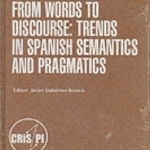From Words to Discourse: Trends in Spanish Semantics and Pragmatics
BookThis item doesn’t have any media yet
2002 | Education
An area of linguistic research can be considered mature when the validity of theoretical and empirical results is tested cross-linguistically and when predictions from different languages influence and modify the course of theoretical development. The semantics/pragmatics interface poses a special challenge in this respect because of its interdisciplinary and multi-theoretical nature. This volume attempts to bridge the gap between theory and empirical analysis by focussing on several aspects of the semantics and the pragmatics of Spanish from a variety of theoretical points of view. Some of the papers were selected from those presented at the International Conference "Semantics and Pragmatics of Spanish" (Ohio State University, 1999). Others are invited contributions from leading scholars in the field. Among the topics covered are several that have been the subject of intense debate, whereas others represent subtle data patterns not considered so far.
The topics include the proper characterization of tense and aspect, the subjunctive, verbal periphrases, stage/individual level predication, the interpretation of infinitives in embedded and adjunct clauses, the subjunctive mood, demonstratives, quantification of excess, exception phrases, binding phenomena, propositional negative polarity items, particles of politeness, and pronominal doubling. Overall, the analysis of these subjects contributes new findings to prominent theories in the field, such as possible world semantics, relevance theory, mental spaces, type coercion, generalized quantifier theory, dynamic semantics, and the theory of logical form.
Related Items:
| Published by | Brill |
| Edition | Unknown |
| ISBN | 9780080439914 |
| Language | N/A |
Images And Data Courtesy Of: Brill.
This content (including text, images, videos and other media) is published and used in accordance
with Fair Use.
